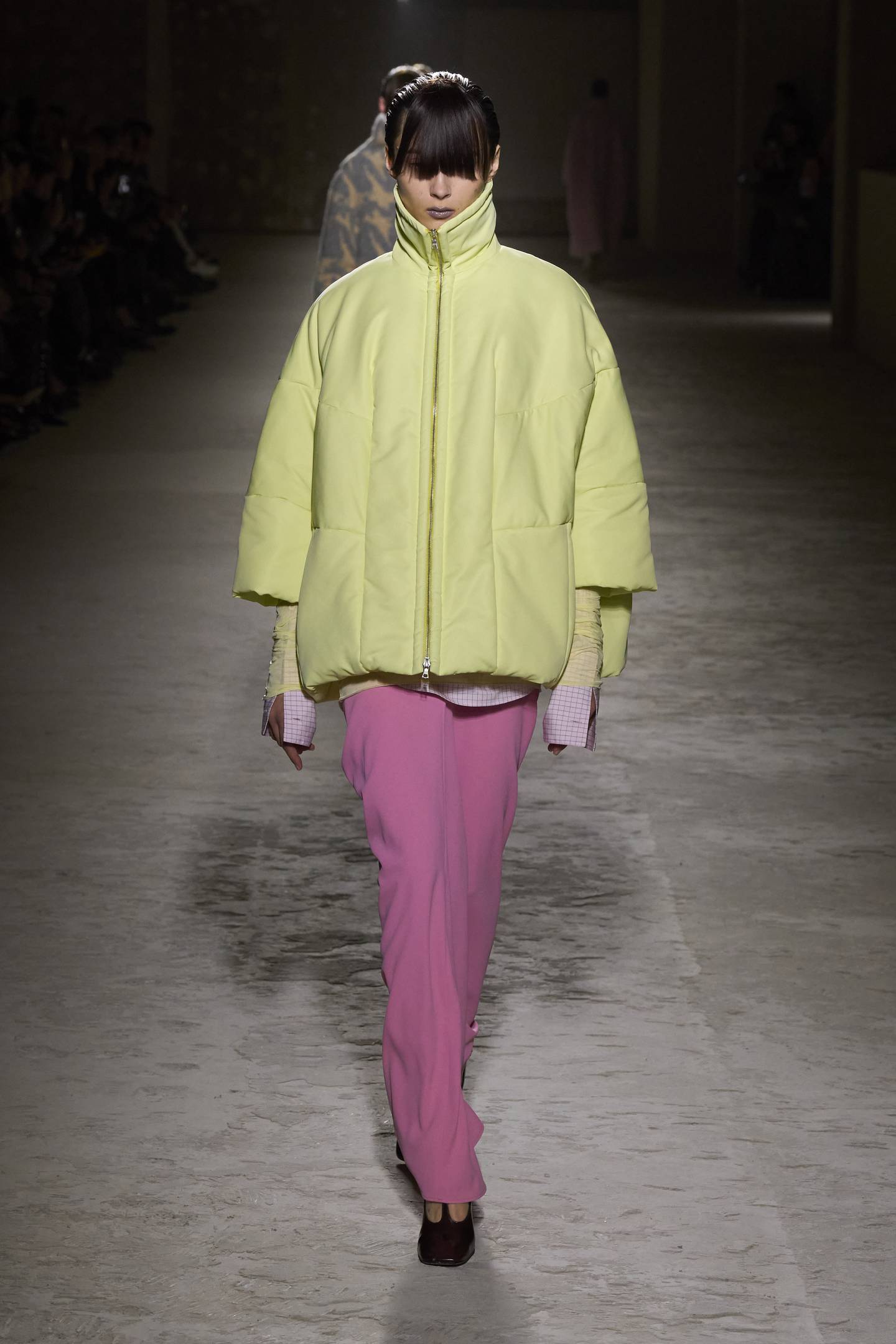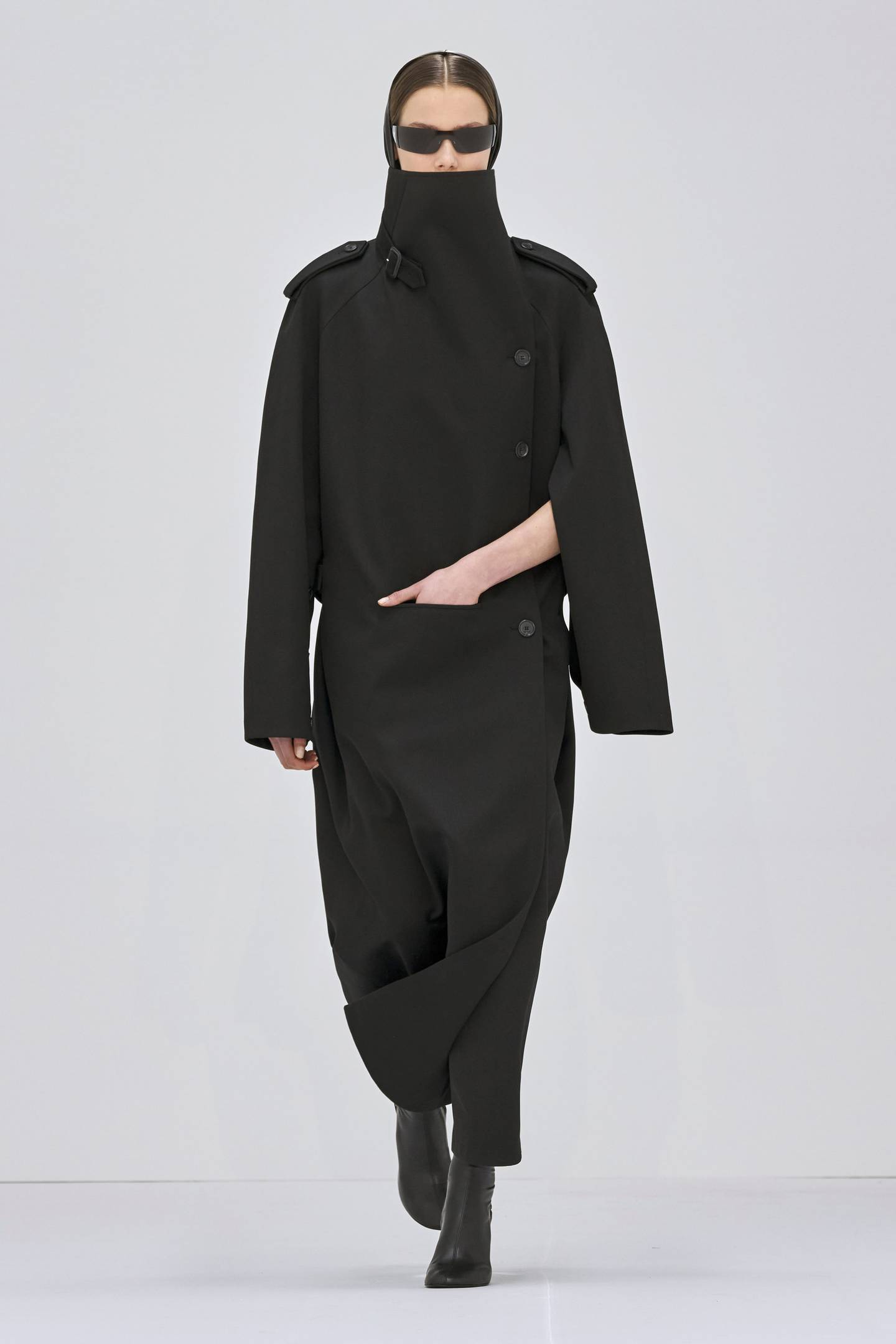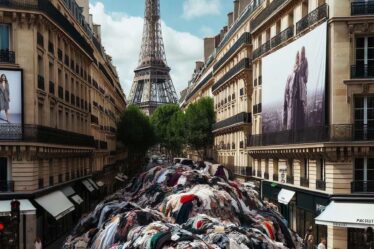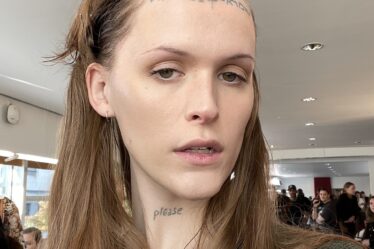
A barefoot woman crossed a huge anonymous space in dead silence. She was wearing jeans and a white singlet which, as she came closer, were evidently fused as one item of clothing. On the soundtrack, a male voice began to tell us about her. She was a single mother, 40 years old, with a little boy who was eight, soon to be nine. While a parade of models made its way up and down the space, the voice lyrically itemised the pleasurable ordinariness of this woman’s life in extraordinary detail. The morning bathroom and breakfast ritual. The job in the law firm, the daily lunch alone in a Greek restaurant, the drive home listening to Glenn Gould playing Bach. The dinner with her son, always illuminated by one candle. Sometimes a movie night. After lights out, she wrote letters (she was a diligent correspondent). Then, bed with a book, one of the thrillers she loved, Raymond Chandler or Dashiell Hammett. Followed by the Big Sleep.
It was a movie in words, and inevitably it sparked the first question Jun Takahashi’s backstage interrogators asked him after his remarkable Undercover show on Wednesday. Who was the poet? Turns out it was the director Wim Wenders, who both wrote and read “Watching a Working Woman”, the text that accompanied the show. “Perfect Day”, his current movie, tells the story of the daily life of a public toilet cleaner in Tokyo. From this unprepossessing starting point, it weaves a moving tribute to the unassailable virtue of the ordinary. It was Takahashi’s inspiration for his collection. This was the point he made to Wenders when they were introduced and he asked him to write a poem to go with the show. Wenders not only agreed to write it, but read it too. Which is why he is the immortal genius he is, and we’re not.
Mind you, Takahashi has a track record with Wenders. His last show drew on the director’s classic “Wings of Desire.” There were angel wings on the runway and, after the show, Takahashi said it was his dream to join those angels. It was like he wanted out. With this collection, he re-engaged with life, “but in an Undercover way,” he stressed. Hence, the extraordinariness of the ordinary. The key was “adhesion”, introduced in that first look, the bonded jeans and singlet. The idea was elaborated on throughout the collection in the way that completely different fabrics came together appealingly without necessarily cohering. A white leather jacket bonded to a striped rugby shirt that insisted on turning into a wrap was the least of it. A knit polo connected with a sequined skirt, a jean jacket was trimmed in gold lame, there were huge outbursts of feathers and trails of tinsel from “ordinary” items of clothing. The last look starred the model who opened the show. She was wearing a track suit trimmed in golden straw, like a pagan wicker man, and behind her was a long golden train. Queen for a day. Transformation complete.
Incidental It Bag alert: Takahashi’s models carried plastic supermarket sacks filled with fruit and flowers and the odd bottle of wine. I’ve learned not to trust my eyes with this designer. I think there was a lot more to these than the audience realized.
I don’t know if Dries Van Noten and Jun Takahashi have ever met anywhere, except perhaps on the astral plane, but they are truly kindred spirits. No one has devoted more of their (lengthy) career to making beauty from the mundane than Dries. Which is why his invitation — a lock of hair — would have been weird coming from almost anyone else (Galliano could get away with it). He explained that it was in keeping with a new narrative strain in his shows. The title for this one was The Woman Who Dares to Cut Her Own Fringe. “She’s quite audacious,” he said. “She decides what to wear for herself.” And for Van Noten, that meant a mix of high and low, couture-level chic connecting with denims and sweatshirts. “If she likes a piece of fabric, she takes it and wraps it around herself. She transforms garments. She wears shirts backwards, all of those things that she does with a natural flare.”
In other words, he was telling a story about style, not fashion. Which is what he’s always excelled at. In his new collection, an elegant padded citron jacket — funnel-collared, three-quarter sleeve — sat over a long skirt in pink jersey. A chunky rollneck sweater topped a complicated skirt in forest green duchesse. A gorgeous lilac jacket, also duchesse, was paired with faded denim Bermudas and gilded bronze boots. Jeans, also faded, were matched with a man-tailored checked jacket whose sleeves were extravagantly embroidered. None of these combinations was easy but all of them spoke to curiosity, fearlessness.

Van Noten claimed the collection was a bit of a dialdown. Details were reduced, buttons and buckles covered, so that the emphasis could be on colour. The palette ran a gamut from pastel pinks and blues to gutsy dark shades, often in combo. It was an open book, which is what the designer wanted. “Fashion is creating really beautiful clothes for people who like the style and want to make it their own,” he said. I was trying to work out why last season’s high/low dialogue felt so much more exciting, and then I settled on Van Noten’s soundtrackists, fellow Belgians Soulwax. For Spring, they shredded Smashing Pumpkins’ “Tonight” and a tantalising handful of iconic female voices. This new presentation stripped Sade’s “Haunt Me” to bare essentials and birdsong, then built it all back up to an orchestral crescendo. Call me shallow but I’m a Pumpkins man. Still, no one uses sound like Van Noten and Takahashi.
Although Nicolas de Felice all but matched them with the aural setting of his new outing for Courrèges. His models walked around a central square where A Thing pulsed with breath drawn and expelled alongside the soundtrack. You had to be there to see the last gasp inhaled and held for a long beat before the finale. The Thing exhaled to a Chopin piano étude. Utterly transfixing.
Nico knows how to make an impression. Courrèges helps, of course. De Felice’s fashion education was informed by iconic images from the house he now creatively directs. His new collection sprang from a picture of a model holding a simple square of silk in front of herself. He associated it with the carré blanc, the white square that French television inserted as an advisory that “the following programming is unsuitable for under-16s.” In other words, it was a cue for taboo, and catnip for a young Nico. He called his version “the magic square” because it looked like it was magically suspended across the chests of his models, hanging off nothing, even when he made it in denim.

He’s now in his third year at Courrèges, but it’s striking how unsettled De Felice still feels. He called his collection “In Search of a Thrill”, like he was craving challenge. And yet he insisted, “We need something more sweet, more reassuring, to make us feel more safe.” His clothes are too edgy to offer reassurance, even to himself. In search of a thrill, De Felice used flou for the first time in the brand’s history. A simple rectangle of fabric cast around the shoulders created the collection’s distinctive big collars, but they also challenged him with bias cutting.
But how much of a challenge could that really be for him? De Felice is a gestural designer, like Jonathan Anderson. His models walked with one hand tucked provocatively in tiny pockets just under their bellybuttons. The stark sexuality of looks like Mona Tougaard’s made you wonder about the hands fitting her in her outfit. The pageant of long, lean silhouettes was practically the quintessence of the ideal fashion show for the outside world, who would probably see an alien nation of arrogant eroticism. And yet the quivering filaments that activated Nico’s last looks suggested something more intimate, more organic, simpler but irresistible. He’s in tune with all the other young creators — Balzy, Martens, Cadwallader et al. — whose next step promises to change fashion.



